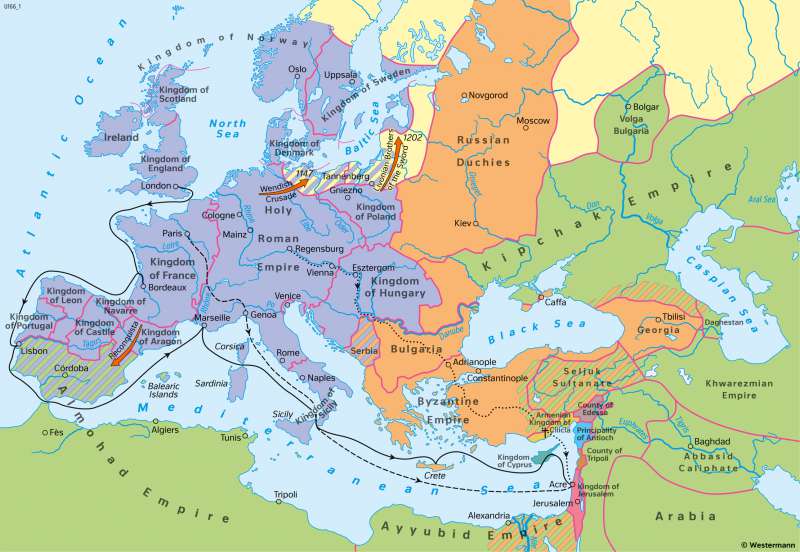Europe - Crusading era (late 12th century)
Middle Ages
978-3-14-100890-6 | Page 58 | Ill. 2

Overview
By 1200, the Christian faith had established itself in almost all of Europe, with only tribal religions remaining in the not yet Christianised areas in the Baltic region and Muslim rule in Moorish Spain. Christianity, however, had been divided into the Latin and Orthodox Churches since the Great Schism (1054) and was threatened in the East by the expansion of the Muslim sphere of power.
The first Crusades
The age of the Crusades began when Pope Urban II received a call for help from the Byzantine emperor because his empire was threatened by the Muslim Seljuks. In 1095, the head of the Latin Church called on all of Christendom to wage a holy war to "liberate" Jerusalem. The enraged masses then fell upon Jewish quarters in Germany and France, murdering and looting, but on their disorganised advance to the Holy Land they were crushed by the Seljuks in Asia Minor. The 1st Crusade, which began the following year, led to the establishment of various Crusader states, the Kingdom of Jerusalem and the principalities and counties of Antioch, Edessa, and Tripoli, but it was extraordinarily costly in terms of losses. While the Christian dominions in the Middle East subsequently weakened themselves through rivalries and disputes about the throne, the Islamic rulers gathered their forces. The reconquest of Edessa by the Seljuks in 1146 triggered the 2nd Crusade. It ended in military disaster and political disagreements among the French and Germans involved.
Non-religious reasons for the Crusades
In addition to religious reasons, there were also social, demographic and economic reasons for the great crusading enthusiasm in the 11th to 13th centuries. The development of feudalism had led to social tensions in many European countries. Due to the sharp increase in population in the 11th century, many peasants and part of the lower nobility had become landless, which greatly encouraged their willingness to emigrate. There were also economic motives for the crusades.
With the founding of urban settlements under the protection of knight's castles and monasteries, there had been a general revival and expansion of trade from the 10th century onwards. For Oriental trade, the Italian port cities in particular needed secure bases in the Mediterranean, which were threatened by the Seljuk conquests.
However, one goal of the Crusades, the reunification of the Latin and Orthodox churches, was not achieved.
Further Crusades
The 3rd Crusade was prompted by the capture of Jerusalem by Sultan Saladin. Led by Emperor Frederick I Barbarossa, King Philip II of France and Richard the Lionheart of England, an impressive army left Europe to recapture the Kingdom of Jerusalem. The German-Roman emperor, who had chosen the land route, drowned in a river in 1190 on his way through Asia Minor. Richard the Lionheart, who had chosen the sea route, first took Cyprus. In 1191 he succeeded in conquering a narrow coastal strip around Acre, where a new kingdom was established. However, greater military successes of this crusade were prevented by the disunity of the participants.
The following crusades failed en route or brought little success. The 7th Crusade of 1248 and the 8th Crusade of 1270 were the last two major efforts of the Occident to come to the aid of the Crusader states. Although Acre was strengthened a little until its final fall in 1291, the crusaders had to give up Jerusalem and the Holy Places. In the meantime, however, the idea of crusading had spread throughout Europe, where the heretical Albigensians and the pagan Pruzes and Estonians in the Baltic region were fought in the name of the cross.




